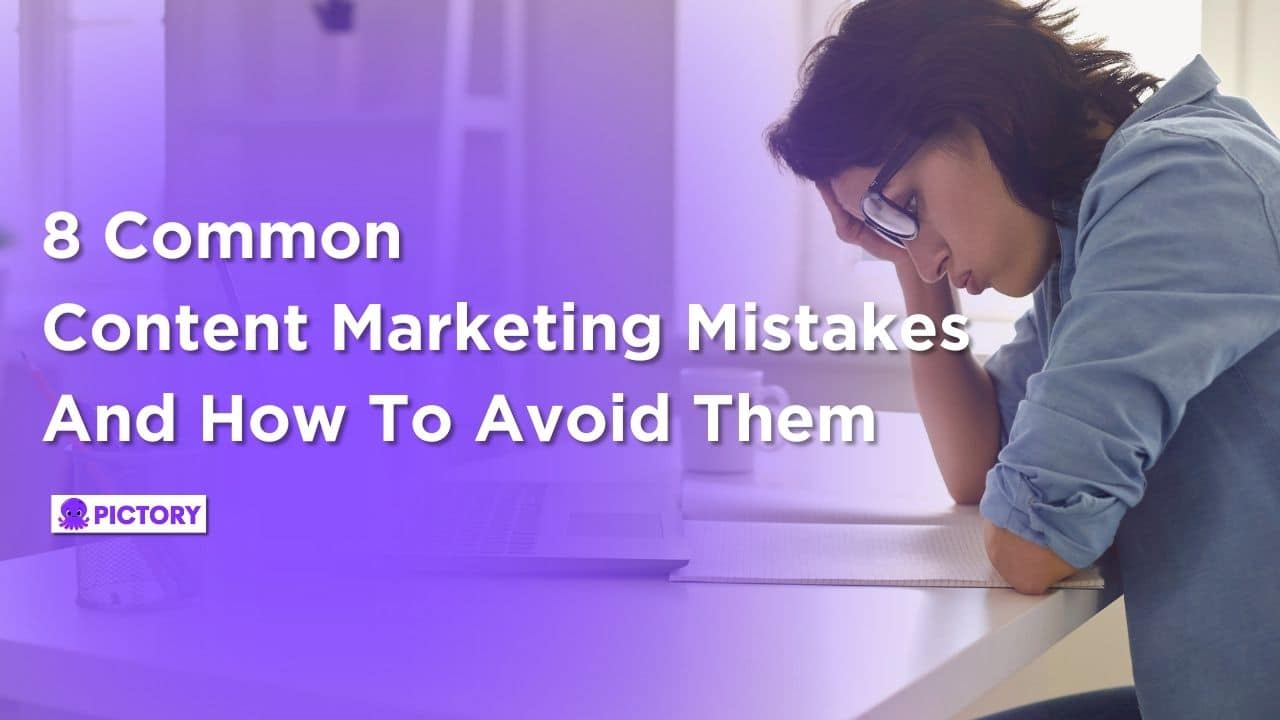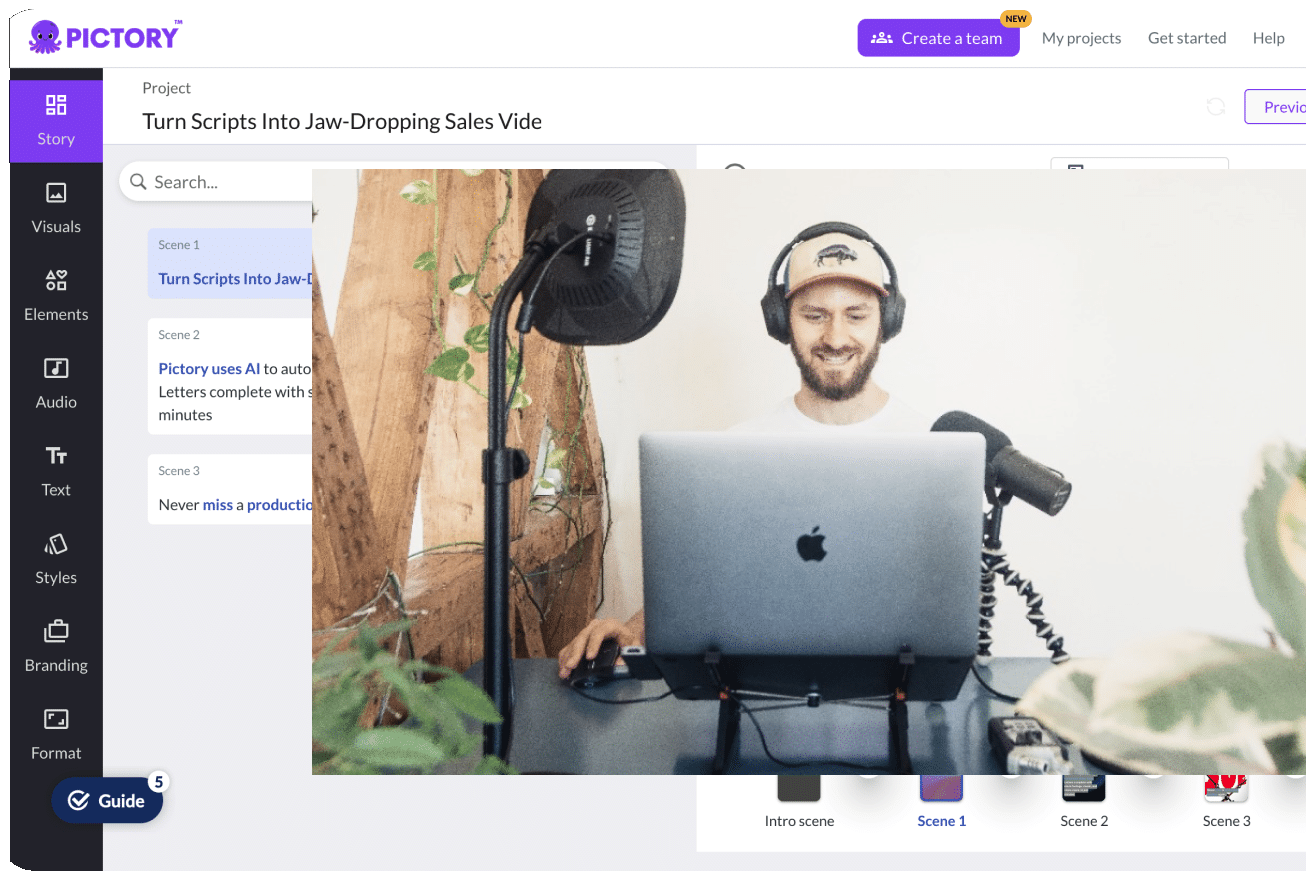Content marketing is one of the most effective ways to boost your brand presence, establish your business as a thought leader, and build a long-lasting relationship with your customers.

Research shows that 88% of marketers have successfully boosted brand awareness and built greater credibility and trust through content marketing.
Interestingly, 70% of customers report getting their purchasing information from blogs, making blogs one of the most cost-effective forms of content in a content marketer’s arsenal.
Whilst content marketing is hugely influential and remarkably cost-effective, just slapping some words on a page is not enough.
Many of the most common content marketing mistakes can cripple your content strategy, cutting you off from the benefits it offers.
Hopefully, this article will provide steps you can take to avoid the most common pitfalls and get your content strategy right the first time.
The Breakdown
Here is a quick summary of what you can expect to learn from this article:
Neglecting your audience research is the best way to waste your time and resources.
The best content in the world is worthless if no one sees it, so make sure you know your SEO best practices.
Not every piece of content has to include in-your-face sales pitches.
Narrative storytelling is your secret weapon as a content marketer.
If you don’t properly promote your content as a content marketer you’ve wasted valuable time creating it because no one will see it.
Failing to adapt to trends is the best way to create stale, irrelevant content that won’t engage your clients.
Build a content calendar! Your editorial calendar will ensure your content stays fresh.
Using the right KPIs to measure your ROI is the best way to refine your content marketing.
You can never collect enough data or feedback.
A Brief Recap of Content Marketing and Content Strategy

Before we get into the mistakes to avoid as content marketers, we must first define our terms.
Content marketing is creating and sharing online content to advance brand awareness and promote interest in products or services.
This includes all forms of long- and short-form content, such as blog posts, TikToks, and Tweets.
The valuable content provided should be timely, relevant, and follow SEO (search engine optimization) best practices to maximize the chances of appearing in search engine results.
Since many of the channels content creators use are free, content marketing is remarkably cost-effective.
This makes it an excellent way for smaller businesses to maximize their marketing spend on a smaller budget.
For companies offering more technical products, content serves as an excellent way to educate potential customers on the benefits of their products and services.
The reality is that if you’re not using content marketing then your competition almost certainly is.

82% of marketers are actively investing in content marketing to connect with their potential customers and spark interest in their products.
The content marketing specialist, manager, or content marketer’s job is deceptively simple, creating exceptional content.
Unfortunately, not all content marketing is created equal.
To help you create the kind of content that connects with and genuinely excites your customers, rather than just getting lost in the churn, here are 8 of the most common mistakes content marketers make and how to avoid them.
Mistake #1: Neglecting Audience Research Kills Your Content Marketing
The first and most crucial step in building your content strategy is understanding what content matters to your target audience.
Conducting effective audience research is the best way to identify exactly what your potential customers value.
You can then produce content that provides the information, education, or solutions they seek.
This establishes your brand as a trustworthy single point of truth while presenting your products or services as the solution to their problems.
Audience research also doesn’t have to be time-consuming or expensive.

Social media polls, keyword research, checking relevant forums for the best-performing posts, and looking into what your competitors are doing are simple and almost entirely free audience research methods.
It’s also worth noting that what your target audience finds relevant is subject to change.
User intent is constantly in flux, so your audience research needs to be an ongoing project.
For many businesses, compelling content is also seasonal.
Different types of content and different topics become more or less effective over the years.
For example, if you run a lawn care business, articles and how-to guides on getting the best and greenest lawn will be most relevant during summer.
In the winter months, switching to articles on keeping your lawn healthy during the winter and preparing for spring will attract much more attention.
While this might seem simplistic, not understanding what their core audience wants and producing irrelevant content at the wrong time is one of the most common content marketing mistakes marketing teams make.
Proper audience research is your best tool for avoiding wasting your time and resources producing content no one will view.
Mistake #2: Ignoring SEO Best Practices in Your Content
SEO, or search engine optimization, is an important tool for a content writer, and critical to effective content marketing.
The best content in the world is not going to draw in any customers if they never see it on search engine results pages.
To get your content in front of your target audience, you need to ensure it appears in their search engine results pages as much as possible.
This is more tricky than it sounds, as search engines constantly change their algorithms and what kind of content they prioritize.

Still, there are some steps you can take to ensure your content gets in front of the right audience.
How to Fix This Mistake
Conduct keyword research – Identifying keywords relevant to your content and industry can help search engines understand the context of your website.
Try using popular tools like Google Keyword Planner, Google Trends, or Ubersuggest to get started.
Optimize page titles and meta descriptions – Make sure each page on your website has a unique, descriptive title tag and meta description.
These snippets will appear in search engine results and should indicate what the page is about.
Link internally and externally – Linking to other blog posts or pages on your website and to reputable external sites is a great way to increase your visibility on the web.
Internal links in blog posts help establish relevance between pages, while external links can help boost trustworthiness.
Make sure to use keyword-rich anchor text when appropriate!
Create content regularly!
Search engines love fresh content, so one of the best ways to improve your organic search results is by creating a content calendar and periodically adding new blog posts or other content.
This helps keep your website up-to-date and ensures there is always something new for readers to enjoy.
Don’t keyword stuff – Although keywords are essential, stuffing them into your content can hurt your SEO efforts.
Keyword stuffing is when you use too many keywords in an unnatural way that makes the content difficult to read.
Instead, focus on writing natural, informative content that contains a few strategically placed keywords and phrases.
Use long tail keywords – Long tail keywords are extremely specific phrases that can help you rank for terms related to your content.
While these are more difficult to target, they can provide more qualified traffic than broader keywords.
Another easy way to boost the SEO ranking of your video content is by including transcriptions and captions.
Read our article on just how video transcription boosts SEO here.
These strategies are just the tip of the iceberg regarding SEO best practices, and becoming an SEO expert is one of the most important things a content marketing specialist can do.
Still, they are a great starting point for getting your content high in the ever-important search rankings.
Mistake #3: Focusing Solely on Content Marketing for Sales
While there is nothing wrong with advertising your products and services as part of your content, focusing on it to the exclusion of everything else is a common mistake.
Modern audiences are savvy, can spot an ad poorly disguised as relevant content from a mile away, and will simply click away, leaving you with nothing but wasted effort.
Constantly pushing for sales can actively diminish the effectiveness of your content strategy.
Instead of only producing content promoting products or services, effective content marketers create high-quality content that solves their customers’ issues.

If your product or service is the solution to that problem, then feel free to promote it.
If it isn’t, create content that offers other solutions anyway (just not your competitors).
Remember, the aim of content marketing isn’t just to promote your product; leave that to the PPC ads.
The objective of creating exceptional content is to engage your audience, build trust in your company, and have your content act as a brand stand that establishes your business as both a thought leader and a single point of truth.
Mistake #4: Overlooking Storytelling in your Content
People love a good story, and the ability to weave stories into your content is essential to connecting with your customers.
The sheer amount of content available is mind-boggling, and to properly connect with your client, you need to produce content that they can relate to.

Good storytelling begins with good writing skills, so ensure your content is well-written and engaging.
Personalization is an excellent way to connect with your reader and can be done by using real-life stories relevant to the topic.
The aim is to create a compelling narrative that catches your target audience’s attention, sweeps them along with the flow of your content’s story, and deposits them squarely on the impression you want them to leave with.
How to Fix This Mistake
Some steps you can take to improve the narrative flow of your content include:
Relate something personal you already know is true.
This content creation tactic helps you be more confident in your content and allows the reader to see you as a subject matter expert.
Use examples – Examples are a great way to bring your content alive and make it more engaging.
Showing how something works practically can be more effective than simply telling people what to do.
Add images and visuals.
Images, charts, diagrams, infographics, and other visuals can be handy in creating an exciting narrative for your content.
They can also help you quickly and easily illustrate complex concepts.
Employ hypotheticals.
A hypothetical situation or scenario sometimes creates excellent content.
You can describe what could happen if something isn’t done and what could be gained if it is.
This type of storytelling can be very effective in helping you get your point across.
Remember, narrative and experience are core to how humans build memory, so make your content stand out by creating a story for your readers to connect with.
Mistake #5: Neglecting Content Promotion
Connected to the need for SEO is the need for proper content promotion.
Your target audience needs to know that you are producing the kind of content that will provide them with the answers they seek.
Content promotion should follow many of the same rules as content creation itself.
The first step is to narrow down what your audience is looking for and what content you have that provides them with a solution.
From there, you need to use the right keywords and phrases to catch and hold their attention and, depending on the channel you use to promote your content, rank highly enough to cut through the noise.
You then need to isolate the best channel to reach them.

Email marketing campaigns, social media posts, and traditional advertising can effectively promote your content.
Content promotion should focus on how your content can ease their pain points and provide practical solutions rather than solely prompting your viewers to buy something.
As we mentioned earlier, if your product or service is the right solution for your customer’s problem, then you should feel free to advertise it.
But there are benefits to creating content that goes beyond just sales, and only concentrating on pushing sales can cut you off from those benefits.
How to Fix This Mistake
Some steps you can take to effectively promote your content include:
Utilizing social media to expand your brand equity and target specific demographics on digital platforms
Leveraging influencers to extend the reach of your content
Using analytics software to identify which channels are most effective for reaching your desired viewers
Establishing relationships with other companies in the same industry or those that provide related services
Participating in discussions and forums
Creating an e-mail list with a content newsletter to build long-term relationships with your customers
These are all simple tactics that you can use to get your content in front of the right eyes and they have the added benefit of being, for the most part, cost-effective.
If you’re unsure of how to effectively use social media in your content strategy, read this article on How to Write the Best Copy for Every Social Media Platform.
Mistake #6: Failing to Adapt Your Content to Match Trends
We’ve already mentioned that what counts as compelling content in the eyes of your target audience is subject to change.
Keeping ahead of those changes and adapting to trends is critical to keeping your content marketing successful.
Customer research is one method we’ve already covered that effectively identifies changes in what kind of content has the most impact on your customers.
However, you can take other simple steps to identify trends and adapt your content accordingly.

How to Fix This Mistake:
- Monitoring forums and social media.
The customer’s voice is always the best indicator of current trends in the market.
Monitoring this can provide valuable insights into what kind of content resonates with users, what topics they’re discussing, and what pain points they need a solution to. Leveraging Google Trends.
You can use this tool to identify what topics have been trending in your industry over the last month.
Part of the Google Analytics suite, Google Trends is a valuable tool for identifying which topics are getting the most attention from your audience.
Keeping up to date with industry news.
It’s important to stay current on the latest developments in your industry.
Not only can this help you create more targeted content, but it also helps to ensure that your content is relevant and timely.
Utilizing customer feedback platforms.
These are great for understanding why customers may leave negative reviews or comments on your content and spotting potential improvement opportunities.
Analyzing data on customer searches.
The search data you gather for SEO can also be used to identify potential topics that customers are interested in and what they’re looking for regarding your product or service.
Studying competitors’ content.
What works for your competitors can also work for you.
Don’t be afraid to look at what your competitors are doing and learn from it.
By staying current on trends in your industry, you can modify your content strategy accordingly to ensure that the content you produce is relevant, timely, and engaging for your customers.
Mistake #7: Not Measuring the ROI of Your Content Marketing
Working in the dark and just hoping your content is working is the worst possible way to implement content marketing.

ROI (return on investment) is the primary metric you should be using to measure the effectiveness of your content marketing efforts.
Unfortunately, ROI can be a somewhat nebulous concept, so using more concrete KPIs (key performance indicators) is an excellent way for a marketing manager to monitor and proactively adapt your content strategy to get the best results.
The KPIs you use will usually be specific to your business, its digital marketing channels, and established goals.
But some of the more common content marketing performance indicators include:
Increase in website traffic – Has the number of website visits increased since you started your content marketing efforts?
How much more traffic have you gained?
Social media engagement metrics – Likes, shares, and comments are a valuable way to measure the success of your content.
Conversion rates – Has the number of visitors who take a desired action on your website increased?
Lead generation – How many leads have been generated by content marketing?
Cost per acquisition – What is the cost to acquire a new customer through your content efforts?
Time spent on page – Tracking the amount of time visitors spend on your page is a good indicator of how engaging your content is.
Bounce rate – If people leave your site quickly, it may suggest that the content isn’t providing enough value.
Conversion rate from organic traffic – Organic traffic is the traffic that finds your content from a search engine and is a good indicator of the efficacy of your SEO efforts.
By tracking these metrics, a content marketer can get a good idea of how effective at creating content and how to adapt it to get the best ROI for your own business goals.
Mistake #8: Ignoring Feedback and Data From Your Target Audience

The customer nearly always has something important to say, and as a great content marketer, you should always be doing your best to listen.
The voice of the customer is the best way to understand what is, and what is not, working with your content.
And proactively soliciting feedback is a critical part of refining how you are creating content into something that works consistently.
The data a content marketer gathers from your various digital marketing channels and your customers is also a vital source of information that can be used to refine your content marketing efforts.
However, collecting feedback and customer data is not the same as using it.
Once you have solicited feedback and collected data, they need to spend time analyzing it for actionable information that you can use to improve the way you are creating and distributing content.
These kinds of actionable insights are some of the most valuable information a content marketer has access to and can be collected for almost no spend!
Use it to optimize your content calendars!
What You Can Do Now
Effective content marketing is a process of constant refinement based on data.

To produce great content that has the most significant impact on your readers, you need to proactively identify your customers, create relevant and timely content, promote that content on the proper channels, monitor the right KPIs to judge ROI, and then edit your strategy based on data and feedback.
By taking the steps above and incorporating them into your content marketing strategy, you can ensure that your investments in content translate into ROI.
In addition to these steps, staying up-to-date on the latest trends and best practices in content marketing is an essential part of a successful career and a great way to impress potential employers.
Now that you know what to avoid, it’s easy to build a good content strategy.
But if you need more advice with the planning stages, check out our guide on How to Best Plan Your Content Marketing.








